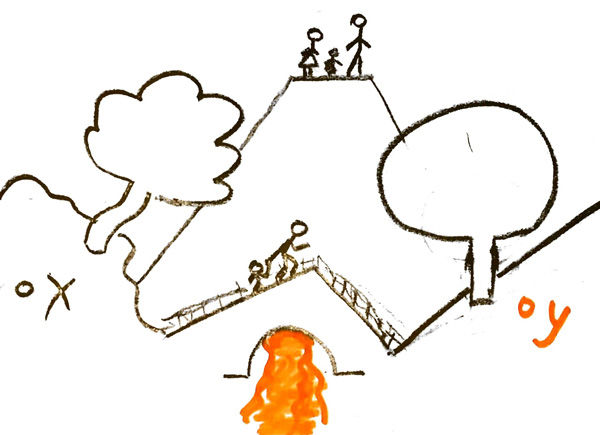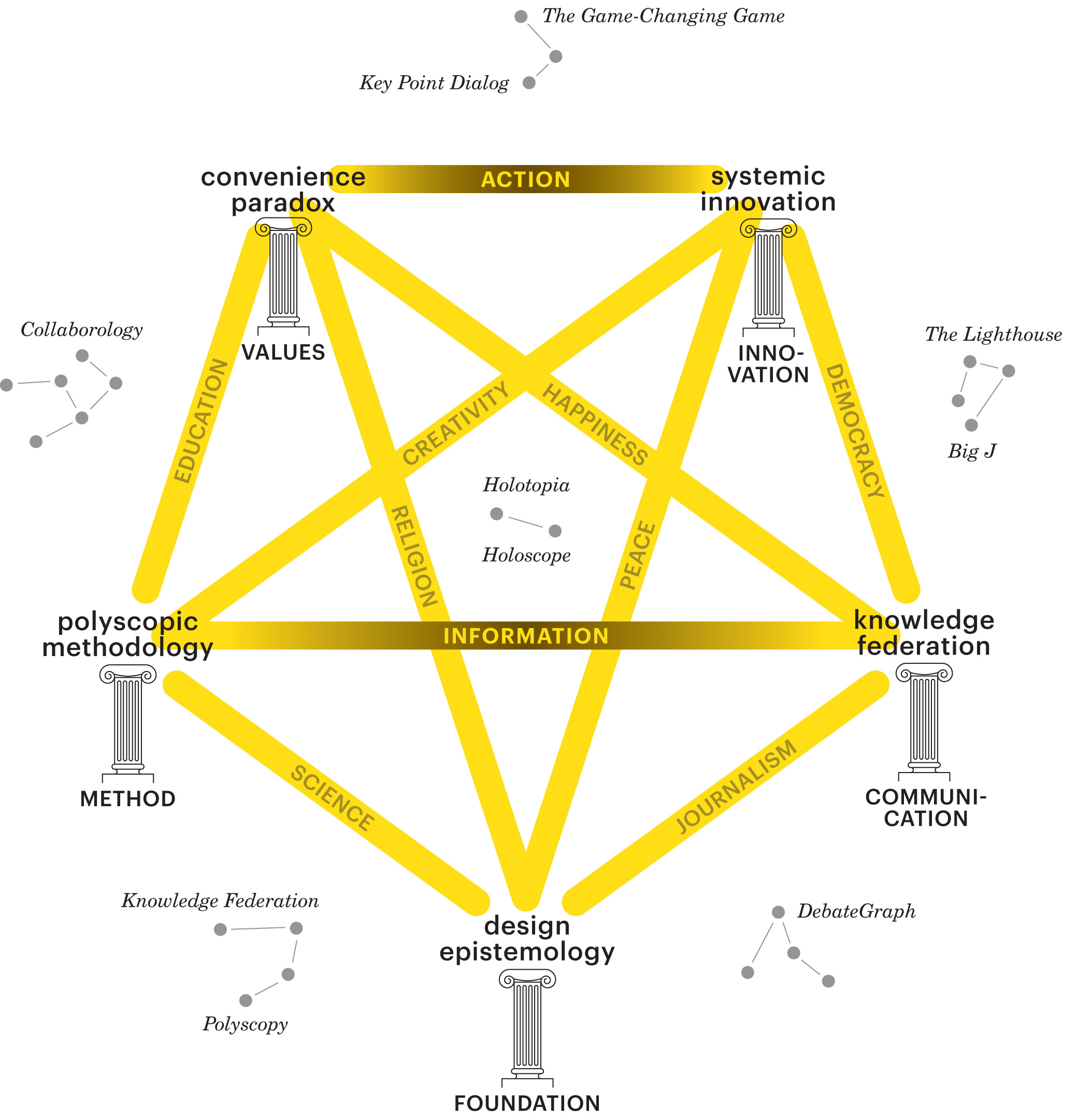Difference between revisions of "N-ideograms"
m |
m |
||
| Line 13: | Line 13: | ||
<div class="row"> | <div class="row"> | ||
| − | <div class="col-md-3"><font size="+1">By representing our society as a bus and our <em><b>information</b></em> as its candle headlights, the Modernity ideogram shows what we must do to "change course".</font></div> | + | <div class="col-md-3"><font size="+1">By representing our society as a bus and our <em><b>information</b></em> as its candle headlights, the Modernity ideogram shows what we must do to become able to "change course".</font></div> |
<div class="col-md-7"> | <div class="col-md-7"> | ||
<!-- ANCHOR --> | <!-- ANCHOR --> | ||
| Line 20: | Line 20: | ||
<p></p> | <p></p> | ||
| − | <p> | + | <p> In One Hundred Pages for the Future, in 1981, based on a decade of The Club of Rome’s research into the future prospects of mankind, Aurelio Peccei—this global think tank’s leader and co-founder—concluded: “It is absolutely necessary to find a way to change course.”</p> |
| − | < | + | <h3>The knowledge federation transdiscipline is a prototype of suitable new 'headlights'.</h3> |
| − | |||
| − | |||
| − | <p> | + | <p>It's an undertaking to do exactly what is needed to empower us the people to change course.</p> |
| − | <p> | + | <p> In his 1969 MIT report and call to action—to institute academic transdisciplinarity—Erich Jantsch quoted Norbert Wiener, the iconic progenitor of cybernetics: |
| + | “There is only one quality more important than ‘know-how’…… This is ‘know-what’ by which we determine not only how to accomplish our purposes, but what our purposes are to be.” | ||
| + | |||
| + | Academic discipline cannot provide us know-what; and the media informing, such as it is, won't do it either. The system that empowers us to use the mind to seek knowledge, the information that liberates us from conditioning and belief and illuminates the course, must combine disciplinary and other evidence; it must transcend academic and cultural fragmentation; it must communicate to the public with the authority of science—in ways that are far beyond the modalities of reaching out that sciences have been able to manifest.</p> | ||
| + | |||
| + | <p>The Modernity ideogram also points to the <em>fundamental</em> change that <em><b>knowledge federation</b></em> stands for: To consider <em><b> information</b></em> as human-made thing for human purposes; notably as the core element of human society and other systems; and adapting it to the purposes that must be served; so that our systems—including our society—can be functional or "sustainable" or </b></em>whole</b></em>.</p> | ||
| + | |||
| + | <p> </p> | ||
| + | <h2>Knowledge Federation ideogram</h2> | ||
</div> | </div> | ||
</div> | </div> | ||
| − | |||
<div class="row"> | <div class="row"> | ||
| − | |||
<div class="col-md-3"><font size="+1">The Knowledge Federation ideogram shows the principle of operation of the 'lightbulb', what makes it work: Instead of <em>reifying</em> our ideas—we create them as a distinct realm; and use them for orientation.</font></div> | <div class="col-md-3"><font size="+1">The Knowledge Federation ideogram shows the principle of operation of the 'lightbulb', what makes it work: Instead of <em>reifying</em> our ideas—we create them as a distinct realm; and use them for orientation.</font></div> | ||
| − | <div class="col-md-7"> | + | <div class="col-md-7"> |
| − | |||
<!-- ANCHOR --> | <!-- ANCHOR --> | ||
<span id="KF"></span> | <span id="KF"></span> | ||
| − | |||
| − | |||
<p> [[File:KF-id.jpg]] <br><small><center>Knowledge Federation ideogram</center></small></p> | <p> [[File:KF-id.jpg]] <br><small><center>Knowledge Federation ideogram</center></small></p> | ||
| − | |||
<p> </p> <p> </p> | <p> </p> <p> </p> | ||
| − | + | <p>The Knowledge Federation ideogram shows two banks of a river joined by a bridge; and there’s a mountain with some stick-figure humans on top in the background. | |
| − | <p> The Knowledge Federation ideogram shows two banks of a river joined by a bridge; and there’s a mountain with some stick-figure humans on top in the background. | ||
The left bank of the river, drawn as a curvy downward slope with a curvy tree, represents the realm of experience; or what’s called “the real world”. | The left bank of the river, drawn as a curvy downward slope with a curvy tree, represents the realm of experience; or what’s called “the real world”. | ||
Revision as of 09:00, 21 October 2023
Contents
Federation through Ideograms
According to dictionary definition, ideograms are pictures that represent ideas; but knowledge federation ideograms are a lot more than that; they stand for knowledge federation's core activity—to condense "one thousand words" into a simple communicatable image; and for the power of new media technology—still so flagrantly misused—to immerse us in impressions and speak directly to our emotions and our unconscious mind; and for the power of the arts to give us imagery that bring us into a new era; as the words of Michelangelo and Botticelli did in the last great cultural revival. The ideograms we have are only a placeholder—for a variety of techniques that will be developed; their aim is no more than point to a direction.
Modernity ideogram
In One Hundred Pages for the Future, in 1981, based on a decade of The Club of Rome’s research into the future prospects of mankind, Aurelio Peccei—this global think tank’s leader and co-founder—concluded: “It is absolutely necessary to find a way to change course.”
The knowledge federation transdiscipline is a prototype of suitable new 'headlights'.
It's an undertaking to do exactly what is needed to empower us the people to change course.
In his 1969 MIT report and call to action—to institute academic transdisciplinarity—Erich Jantsch quoted Norbert Wiener, the iconic progenitor of cybernetics: “There is only one quality more important than ‘know-how’…… This is ‘know-what’ by which we determine not only how to accomplish our purposes, but what our purposes are to be.” Academic discipline cannot provide us know-what; and the media informing, such as it is, won't do it either. The system that empowers us to use the mind to seek knowledge, the information that liberates us from conditioning and belief and illuminates the course, must combine disciplinary and other evidence; it must transcend academic and cultural fragmentation; it must communicate to the public with the authority of science—in ways that are far beyond the modalities of reaching out that sciences have been able to manifest.
The Modernity ideogram also points to the fundamental change that knowledge federation stands for: To consider information as human-made thing for human purposes; notably as the core element of human society and other systems; and adapting it to the purposes that must be served; so that our systems—including our society—can be functional or "sustainable" or </b></em>whole</b></em>.
Knowledge Federation ideogram
The Knowledge Federation ideogram shows two banks of a river joined by a bridge; and there’s a mountain with some stick-figure humans on top in the background. The left bank of the river, drawn as a curvy downward slope with a curvy tree, represents the realm of experience; or what’s called “the real world”. The right bank of the river, drawn as a simplified and abstracted mirror image of the left bank (the river bank is a straight line; the tree is a rectangle with a circle on top) represents the realm of ideas; or what Einstein called “the totality of the concepts and propositions that are laid down in books”. The bridge joining those two banks represents the methodology. The mountain in the background suggests that the realm of ideas needs to be structured as a holarchy (as I explained in Chapter Two); or metaphorically—that information must elevate us above everyday jungleness and help us see things simply and clearly; and that we indeed need both big-picture views (showing ‘lakes and forests’) and detailed views (to help us ‘navigate through the trees’). When we look from the mountain top we see things in proportion; we can then set priorities correctly. The methodology ‘bridge’ makes it possible to take an issue or question—any issue or question from the realm of experience—to the realm of ideas; and theorize it, and comprehend it, and see how it may need to be handled. We can then take the resulting insights back to the practical world—and act in an informed way.
Point — principle of operation is that instead of conflating or reifying; instead of expecting information to "correspond to reality"—we create an independent realm of ideas; notably by using abstraction in suitable ways. Methodology allows us to theorize any theme from real life. Mountain to elevate ourselves above the information jungle; and see things in simple ways. Horizontal abstraction is like creation of keywords—they are ways of looking, simplifications; which allow us to talk about things in experience or "reality" in simple and clear terms.
Vertical abstraction allows us to create simple general insights; like Newton's laws—in all walks of life. By federating what's been found out in various realms.
Holotopia ideogram
Holotopia ideogram shows the result of it. When the vertical abstraction is applied—when we've federated what we need to know about five pivotal themes (innovation, information, foundation, method and values)—we arrive at five insights that elevate us above the world and allow us to comprehend directions. Each of the five is completely reversed. We can then use the five insights to contextualize comprehension and handling of various other themes (represented by ten themes).



